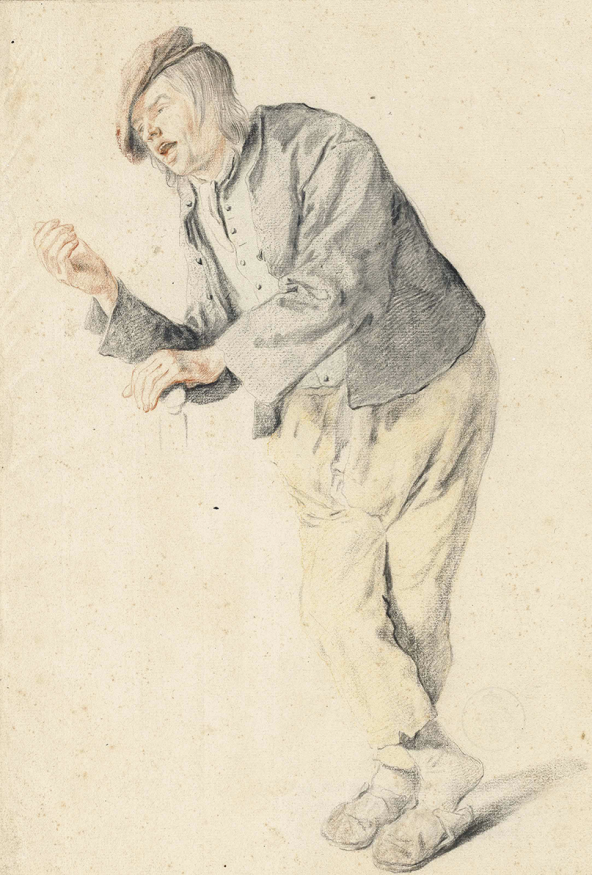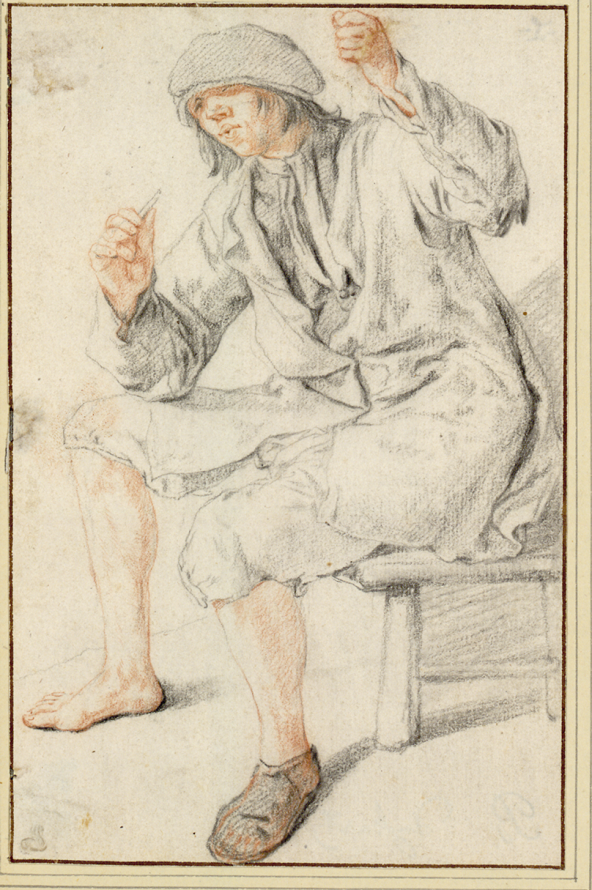Choose a background colour
Cornelis Dusart, Dutch, 1660-1704: Study of a Young Man Standing with His Foot on a Stool, c. 1690-1700
Black and red chalk on paper; framing lines in black ink.
10 3⁄16 × 5 11⁄16 in. (25.8 × 14.5 cm)
- Chain Lines:
- Vertical, 24 – 26 mm.
- Watermark:
- Seven Provinces (Vryheyt); similar to Laurentius and Laurentius, vol. 2, nos. 739, 756A.
- Provenance:
Sale, Frans Théonville, Utrecht, 20 May 1932, lot 40; sale, Christie’s, Amsterdam, 14 November 1988, lot 41; Sheldon and Leena Peck, Boston (Lugt 3847); gift to the Ackland Art Museum, inv. no. 2017.1.25.
- Literature/Exhibitions:
None.
- Ackland Catalogue:
- 2017.1.25
Cornelis Dusart’s full-length studies of figures in dynamic poses are innovative for their use of multiple color chalks. His use of red to suggest areas of exposed flesh especially adds to the lively appearance of his subjects. Dusart made over 200 drawings for studio use of young men relaxing, drinking, and enjoying themselves, but only a fraction of them survive today. The figures typically display some level of drunkenness as a comic element as well as varied facial expressions and active gestures. The man here, while not obviously under the influence, may be a tavern- goer based on his carefree pose, relaxed grin, and the slack stocking on his right leg.
Cornelis Dusart made a number of full-length figure studies in chalk that explore dynamic poses, often using young men whose dispositions suggest relaxing, drinking, or general enjoyment. These studies have been linked with those in an album in Dusart’s postmortem inventory described as: “Men drawn from life by Dusart, 251 pieces.” 1
Only a fraction of that number survives today, with perhaps fewer than three dozen sheets fitting such a description. They provide us with a valuable record of Dusart’s approach to mastering the complicated poses required of a painter who specialized in humorous and often raucous genre scenes. While it is clear from his inventory that he created and held onto these studies for studio use, they function today as comic drawings that delight in their own right, depicting characters seemingly plucked out of Dusart’s paintings for closer appreciation and a more relatable, direct encounter.
Dusart would sometimes use the same models on more than one occasion. The young man here bears similar features and wears the same cap as a model for a figure study that recently appeared on the art market Fig. 64.1.

Cornelis Dusart, Young Man Leaning on a Chair. Black, red, and yellow chalk, with touches of brown and gray wash on paper, 305 × 210 mm. Present whereabouts unknown.
2013 Christie’s Images Limited
The figures in both this and the Peck drawing lean against the back of a lightly sketched chair. Another candidate for the same model can be found in the Young Man Seated with a Pipe in the Albertina Fig. 64.2.2

Cornelis Dusart, Young Man Seated with a Pipe. Black and red chalk with gray wash on paper, 176 × 113 mm. Vienna, Albertina, inv. no. 10406.
Albertina, Vienna
This latter figure has more obviously imbibed a few too many drinks. Dusart often conveyed drunkenness in these figure studies in order to intentionally complicate the expressional gestures, and of course to add an element of humor.3
The young man in the Peck drawing seems somewhat sober by comparison (or at least less ragged), but his slightly slack jaw and jaunty pose, not to mention the slipped stocking on his right leg revealing a bit of flesh, all suggest that he could nevertheless easily represent a figure from a pub environment.
While he was closely influenced in style and drawing practice by his teacher, Adriaen van Ostade (1610 – 1685), whose studio contents he would later own, full-length figure studies like these are more particular to Dusart.4
Though he was not the first Dutch artist to make full-length figure studies, he was certainly innovative in his use of multiple color chalks to do so.5
He often used red chalks to suggest flesh areas, as one sees here in the face, hands, and exposed calf. Such an approach gives these works a forward-looking appearance, one more typically found in the eighteenth century. Dusart likely circulated a few of these drawings, some being signed and dated, but most probably remained with the artist.6
Assigning dates to works like this one can be problematic, but a date in the early 1680s, at the beginning of his career, seems most plausible.7
End Notes
Bredius 1915 – 22, vol. 1, 65. See G. Luijten in New York, Fort Worth & Cleveland 1990 – 91, 95 – 97, no. 32; and W. W. Robinson in Amsterdam, Vienna, New York & Cambridge 1991 – 92, 210 – 11, no. 96.
Young Man Leaning on a Chair, Christie’s, London, 3 July 2013, lot 47; and Young Man Seated with a Pipe, Vienna, Albertina, inv. no. 10406. A substantial number of other drawings depict a young man of a similar age and appearance, such as the Young Peasant Seated, Paris, Fondation Custodia, Collection Frits Lugt, inv. no. 2000 (New York & Paris 1977 – 78, 51, no. 33, pl. 106); and A Seated Man, Rotterdam, Museum Boijmans Van Beuningen, inv. no. MB 338 (New York, Fort Worth & Cleveland 1990 – 91, 95 – 97, no. 32, with further examples of possibly the same young man). See also Seated Boy with a Book, Amsterdam, Rijksmuseum, inv. no. RP-T-1881-A-103 (Amsterdam & Washington 1981 – 82, no. 43, 111); and Seated Young Man with a Fur Hat, Vienna, Albertina, inv. no. 10402 (Milwaukee 2005 – 06, 134 – 37, no. 63).
For examples of similar studies with drunk-appearing figures, see especially the Seated Man with a Large Hat in the Fogg Museum, Cambridge (Robinson & Anderson 2016, 110 – 12, no. 28); and the same model in Seated Man Sticking Out His Tongue, Haarlem, Teylers Museum, inv. no. S17. See also F. F. Hofrichter in New Brunswick 1983, 74 – 76, no. 34; suggesting that these drawings portrayed a commedia dell’arte actor, given his clothing, which would put the appearance of drunkenness more in the mode of farce.
Amsterdam & Washington 1981 – 82, 110 – 12.
W. W. Robinson in Amsterdam, Vienna, New York & Cambridge 1991 – 92, 208 – 09, no. 95.
For a group of these figure studies dated 1686, see the entry by W. W. Robinson in London, Paris & Cambridge 2002 – 03, 204 – 05, no. 89.
A similar watermark is found on Young Peasant Seated, Paris, Fondation Custodia, Collection Frits Lugt, inv. no. 2000 (New York & Paris 1977 – 78, 51, no. 33, pl. 106; with the watermark illustrated on p. 200). Susan Anderson dates a related study in the Fogg Museum, Seated Man with Large Hat, to circa 1685 (Robinson & Anderson 2016, no. 28, 110 – 12).
